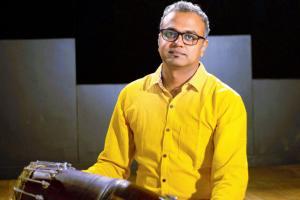A musician trained in Carnatic to helm a workshop that illustrates an age-old Indian vocal percussion tradition

Viveick Rajagopalan
Having a sense of nationalistic fervour is bandied about these days as if it's something that's as important as being a humane person. But musically speaking, if there's one thing that we can be truly proud of as a country, it's our age-old tradition of mastering the art of percussion. We aren't talking necessarily about the tabla here. Or, say, the dholak. For, our musical culture is so rich that it involves a 5,000-year-old technique where the human voice acts as a percussive instrument. That technique is called konnakal. You've most likely heard it when Indian classical musicians keep "taal" in the form of vocal beats where, say, a person goes "taa dhum taka dhum" (or something else on those lines). And a workshop this evening will illustrate how it can apply not just to music, but even to the other arts, like oratory and writing for instance.
ADVERTISEMENT
Viveick Rajagopalan, a mridangam player who will be conducting it, tells us, "The idea of having a language of percussion is unique to India in the sense that it was really evolved even centuries ago. And konnakol was a language that was used to teach people instruments. But what happened is that it eventually became an art form by itself. That kind of died down with time, though the vocabulary — or the language — remained."

Trilok Gurtu is a modern musician who uses konnakol in his melodies
He continues by saying that the purpose of this language — like all others — is to communicate. Plus, it has a mathematical structure to it. It's not random. "If we take the human body for example, every skeleton looks the same. That's the mathematical part. But we are all shaped differently and feel differently. That's the musical part," Rajagopalan says, adding that while earlier konnakol was prevalent mainly in southern India, it's actually a language that anyone anywhere can use, including rappers or beat boxers, to use obvious examples.
The objective of the workshop, though, is to show how this technique can apply to professions outside of music as well. Rajagopalan tells us, "See, if I know what a taal is constructed of — say it's 'tarakita thha' — I will know how to alter it. Similarly, if you're a writer, and you want to write a piece of poetry with a certain rhythm, you'll be able to understand the patterns better [if you know konnakol]. Your vocabulary increases. You know when to put a comma, and when to end a sentence."
ON Today, 11 am to 2 pm
AT Island City Studios, 301, Empressa Building, 2nd Road, Ram Krishna Nagar, Khar West.
Log on to instamojo.com
COST Rs 2,000
Catch up on all the latest entertainment news and gossip here. Also download the new mid-day Android and iOS apps to get latest updates
 Subscribe today by clicking the link and stay updated with the latest news!" Click here!
Subscribe today by clicking the link and stay updated with the latest news!" Click here!







